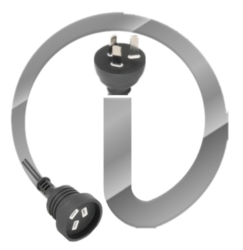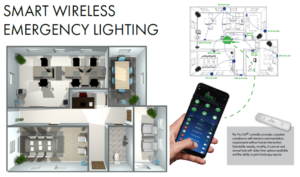Testing Portable Residual Current Devices
Why I No Longer Use An RCD Test Label On Portable RCD’s
Warwick Shirreff instantsafetychecks.com
26 September 2021
Portable Residual Current Devices (PRCDs) are often used on worksites and in industrial areas, as well as in some garages and backyards.
And with good reason!
Sometimes we may come in contact with an unsafe situation, maybe without even realising it, and any situation involving Mains Electricity has the potential to be deadly.
PRCD’s are used when we are using hand-held or plug-in devices. While we may carefully check for any damage or fault BEFORE we plug the device in… (mostly we don’t) and we may have the devices tested regularly (this is enforced for construction sites etc. but mostly forgotten about at home) some faults aren’t immediately noticeable.
The way any electric appliance operates is that power from the mains comes up the active line (live or hot wire in some countries) when you close the switch it flows into the appliance causing it to heat, turn, light up, or whatever it is designed to do, and then returns down the neutral line to the main earth (MEN connection).
The circuit must be complete for this to function, that’s why you have to close the switch. An open circuit doesn’t function.. BUT STILL HAS THE POTENTIAL TO BE DEADLY.
The mains voltage (230-240 Volts here in Australia and most countries, 100-120 Volts in USA and a couple of other areas) is the difference in Electrical Potential between the supply and Earth.
Earth can be any connection back to the Neutral/Earth connections, or the ground around us, or the structure of a building. Most installations should have a connection binding the metal framework, water pipes, the MEN connection and an Earth stake. In some areas it is known as GROUND.
Electricity wants to do only one thing, get to Ground!
This is why an accidental connection anywhere on the circuit to the frame or earth wire etc will cause a Short Circuit. The shortest route to ground is the course it takes rather than doing any work, like driving your drill or lighting up your area.
Most circuits will have what is known as Protective Earth, or simply the earth wire. This provides an unrestricted pathway back to the MEN connection so if anything is damaged the current takes this easy route and the flow, hopefully, exceeds the fuse or circuit breaker rating, which trips and interrupts the flow.
Not all appliances include this Protective Earth, some are rated as Class 2 or Double Insulated. These will normally only have 2 pins on the plug (but not always). The insulation is rated as sufficient to prevent any accidental connection with live components.
So that covers the Normal situations,
What happens when things go wrong?
If you “accidently” become a part of this electric circuit… (Electricity considers you an adequately sized body to be an earth) the electricity will attempt to flow through your body. This can cause severe burns, but also, the impulses are similar to the impulses your brain sends through your body to operate muscles etc.
Can you imagine what your heart muscles do when they get “instructions” to beat at 50 beats per second (50 Hz supply here in Aus, UK etc, or 60 Hz in USA) instead of a sedate 72 beats per minute?
At 100mA or more, the resulting Heart Attack or Cardiac Infarction is usually fatal.
So How Does A PRCD Help?
Using a Residual Current Device (or Ground Fault Current Interrupter GFCI in USA) can prevent this scenario occurring. The RCD device monitors the current coming in on the Active wire and compares it to the current returning down the Neutral wire (It does NOT connect to the Protective Earth)
If this current is out of balance by 30 milliamps or more, it will trip and disconnect BOTH the Active AND Neutral wires…. within milliseconds…. so that a fault cannot continue to Earth anywhere in the circuit.
This 30mA is known as Earth Leakage, or Ground Fault Current, or Residual Current.
This interruption limit is deliberately well below the level that would be considered dangerous, and the time frame must be less than 300ms.
Most new houses built in Australia will have RCS’s (Safety Switches or Earth Leakage Devices) built into the meter board. These may cover all circuits, or may only protect those regarded as “accessible”. Older houses and buildings may not have any of these fitted, or may have been fitted with some when the switchboard was upgraded.
If there is no RCD fitted where you are working, you can plug a PRCD and plug into the circuit and press the TEST button to ensure it is functioning, and THEN plug your device into this.
If the Test button does not trip the breaker, then either there is no current to monitor (circuit is not on) or the device is faulty and WILL NOT SAVE YOUR LIFE.
If your circuit is live, ie plugging something else in that works, but the PRCD does NOT trip,
THIS DEVICE SHOULD NOT BE USED until checked by a competent person.
Testing A PRCD
All appliances should be tested regularly for electrical safety. AS/NZS 3760- In-service safety inspection and testing of electrical equipment– sets out recommended test frequencies, which may be regulated in your industry, or which normally would not exceed 12 Months.
Testing a PRCD fits into this as well, with the added proviso… The Test button should be operated Before every use.
Some pedantic “site safety officers” feel that that the Wiring Rules (AS3000) call for the RCD to be tested every month. This actually refers to an installed RCD which may then be in constant use.
Pushing the Test button REGULARLY will prove that the device is in fact working, and if it fails should be referred to a qualified Electrician.
However, a PRCD, being a plug-in device, comes under AS/NZS 3760, and should be tested (and tagged) every 3 months if being used in construction or mining, etc.
This test involves a Lead Test (for every outlet) and a push button trip test (device must be plugged in for this part of the test). You could also test with an RCD Tester (in each outlet).
If testing with an RCD Tester, or Multi-function Tester, the device should be plugged in via an Isolation Transformer to avoid tripping other breakers further up the line. Some Portable Appliance Testers (PAT tester) include an inbuilt isolation transformer for this purpose.
When the PRCD is built, and approved for use in Australia, the manufacturer will conduct a series of tests similar to those set out in AS3000 for the electrician to test when he completes the installation.
These include…
- Test at Half the trip current At 15mA the RCD should NOT trip
- Test at rated current At 30mA the RCD SHOULD trip in less than 300ms
- Test at 5 times trip current At 150mA the RCD SHOULD trip in less than 200ms
- Ramp Test Increasing from zero RCD SHOULD trip at less than 30mA
- Repeat tests at 180 Degrees Because AC sine wave goes Positive then Negative you want to ensure it trips similarly on both halves of the sine wave.
When testing an installed unit, or when plugging in a PRCD and testing it, the push button test proves that it is still functioning as per the above series of tests.
How About The Label?
The pedantic “site safety officers” may require an RCD test label to be affixed with the trip time filled in by the tester. These labels are actually made for a fixed installation and are not designed for PRCDs.
The trip time usually decreases as the unit ages, and can vary with environmental factors, and also depending on the tester used. Provided the time is less than 300ms it is not relevant.
In testing hundreds of devices before they went out for hire, I used some of these labels, indicating the maximum trip time at 30mA (usually 10-40ms depending on the unit) and I found that some items were “tested” the next day by someone unfamiliar with the test process and a label affixed with whatever figure appeared on their tester screen, which bore no resemblance to the trip current.
At that point I stopped using the stickers, (being for fixed installations they are not removable!) especially as many were fixed over the ‘window’ covering the actual RCBO (Combined RCD and Over Current circuit breaker) making it difficult to determine it’s status.
In answer to those who insist it MUST have a label to show it tripped at less than 300ms, My reply is… “If it did not trip within that time, it would not be fitted with a test tag, as it did not comply with AS/NZS 3760. If you are not sure on that point, plug it in and do a push button test”
If it will not trip for a push button test, it will not trip whatever test you do. If it does, then it complies with all the other test criteria.
Why They Fail To Trip
The main problem with PRCDs that will not trip, we find in items that come back from hire, is that the testing has been performed by a licensed electrician, using his “Megger” tester.
For a fixed installation, the requirement is for the electrician to perform an Insulation Test (or Megger as they are commonly known) AFTER having disconnected the RCD from the circuit.
This test should be conducted on the 500V setting (double the working voltage of 240V)
However, most Meggers have a 100V setting (for use on 440V/480V systems, or for DESTRUCTIVE testing of cables for approval purposes) and a lot of sparkies use that as their default setting.
After all, it does make a bigger bang!
So seeing as how they CANNOT remove the RCD from the circuit, and their standard procedure is to “test” with the Megger on 1000V….
The PRCD passes the insulation test, but when they go on to the next stage to test the RCD, the unfortunate RCBO that has just had it’s electronics fried by a voltage FAR IN EXCESS OF WHAT IT WAS DESIGNED TO COPE WITH cannot rise to the occasion.
Either it is fried in the OPEN position… so you can’t use the appliance as there is no voltage coming through it, or WORSE, fried shut… so you DON’T WANT to use it, as it provides NO protection.
So as the actual trip time can vary, depending on the environment, the age, the part of the sine wave, the applied test current (from different testers) I don’t see the relevance of marking it on the item.
If someone else were to test it… they wouldn’t be proving me wrong, they would prove that it can vary.
I would rather put a warning label… Keep Out Of The Reach Of Electricians With Meggers!





